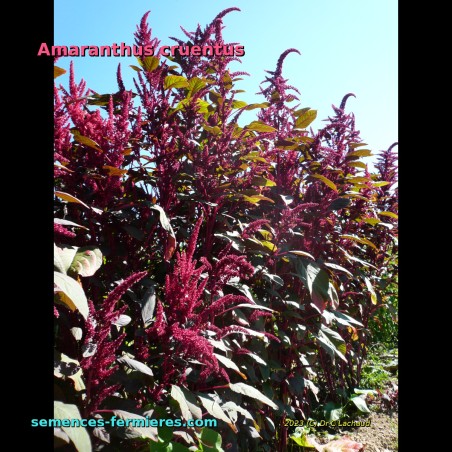










Amaranthus cruentus - Red Amaranth
1 packet of 50 seeds
-
Red Amaranth is native to tropical America and was domesticated very early by the Native American peoples (6000 years ago)
Aztecs, Mayans and Incas grew it and gave it a sacred signification
Amaranthus cruentus is a tall, annual herbaceous plant with very rapid development and high biomass production (equipped with the C4 atmospheric carbon fixation system)
It is edible, although one should avoid consuming if it was grown in soils naturally rich in nitrogen (concentrates the nitrogen, which makes it toxic)
It is therefore necessary to avoid adding mineral fertilizers to this crop
Red Amaranth produces, on a solid branched stem supported by a tap root, large tender leaves, and colorful and decorative inflorescences, grouped in more or less dense and heavy panicles at the top of the stems
The Red Amaranth is a cousin of Quinoa, Epazol, Swiss Chard, Beetroot, Orach, Spinach, Glasswort, and also several other invasive species of Amaranths (Amaranthus cruentus is not invasive)
Amaranthus cruentus is cultivated on an industrial scale, particularly in North America including Canada, Africa and Asia
Many varieties of Amaranthus cruentus have been selected, which are divided into 2 groups:
The variety offered here belongs to the 2nd group, its black and too small seed cannot be consumed
-
| Jan | Feb | Mar | Apr | May | Jun | Jul | Aug | Sep | Oct | Nov | Dec | ||
|---|---|---|---|---|---|---|---|---|---|---|---|---|---|
The seed is tiny but can be buried without hindering germination
Sow directly in place in May, on clean, well-loosened, moist, warmed soil, in a sunny position
It is not necessary to sow earlier in a nursery in pots, because Amaranthus cruentus grows very quickly and its seedlings do not require this level of protection
Disperse the seeds well to avoid, above all, overcrowding (unless you are growing Red Amaranth for young leaf vegetable)
Indeed, Amaranth can become very large
Lightly rake the soil to incorporate the seeds just on the surface
If you are growing Red Amaranth as a green, you can also sow in rows spaced 30cm apart, regardless of density
Germination is fast (within a few days) when the weather is hot
Keep the seedling clean: Because this variety gives red vegetation and the sprouts already have this color, distinguishing them from weeds is easy
Thin out as the plants develop, harvesting the less attractive individuals for cooking or for your dyeing needs
This procedure allows only the most beautiful specimens to be kept for ornament
To use Purple Amaranth as a Dye, the foliage, the stem, and especially the inflorescence, are the sources of pigment to harvest
You might also like
Payment :
PayPal < 150 €
Check < 850 €
Bank Wire > 149 €
Thank you for your kind understanding